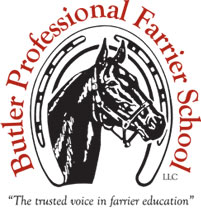Punching a horseshoe nail hole that is clean so the nail fits tight and is safe for the horse is an art that must be perfected to be useful and practical. The hole must be positioned over the outside of the white line to be safe. The hole should have pitch to match the angle […]
What value is farrier certification? If the horse owning public doesn’t know what it is, how difficult it is to do the accurate work necessary to obtain it, and the value it has for their horse(s) – it has little value. If it becomes nothing more than a fraternity initiation which includes hazing, it has […]
The anvil is one of the most important tools used by the farrier. Chances are you will only choose your anvil once. Its choice should be a matter of study as it will affect your work as much as any other tool. Its use and location should determine your selection. Types, Makes, and Weights of […]
“Doug, I attended your Horse Expo seminar this past March in Lincoln and really enjoyed your lecture. I never thought that I would have to bring out notes from what you talked about in such a short amount of time, but we ended up having a horse go lame on us this spring. We saw […]
The best way to tell the position of the Distal Phalanx, or P3, is to have a lateral/medial radiograph of the hoof. Usually, the foot will have to be placed on a block to get the x-ray beam parallel to the base of the bone. Without an x-ray, you can look at the slope of […]
Hoof wall thicknesses vary. There is a very small margin for error. The farrier must pay close attention to selecting and driving each nail. Not all nails are manufactured perfectly, and misshapen nails might not drive straight. However, nail quicking isn’t the only kind of quicking that can affect a horse – he can also […]
I believe the NC Tool hoof knife is the best value for the money. They come sharp and are easy to keep sharp. And they are relatively inexpensive to replace. I think the best hoof knives in the market are Ringel knives. I use them in my work, for they are made of high quality […]
This question and its answer depends upon your experience, length of time in practice, how many clients you currently have, status of your local economy, competition, etc. Do you provide perceivable value for your clients? How will you communicate this change — will you call and tell them, send them a letter, postcard or email, […]
Answer: You are not required to read all the pages before you arrive. You’ll find after enrolling and completing the application process that a copy of P3 will be sent to you, and you are at liberty to use your copy to read and study as you wish. There is a homework assignment on five […]
Answer: A hoof that is proportional to the horse’s body size allows for ideal distribution of body weight over the foot’s laminar surface. (Laminar surface refers to the area where the sensitive laminae, attached to the coffin bone, interlocks with the horny laminae at the hoof wall.) When the foot is proportional to body size, […]
Butler Professional Horseshoeing School
495 Table Road
Crawford, NE 69339
(800) 728-3826
jacob@dougbutler.com
If you think you want to become a farrier (or know someone who does), this book can help you make that decision. Horse owners will learn the importance of choosing a qualified farrier and how to select the “right” one.
[ Get the e-Book Now! ]
